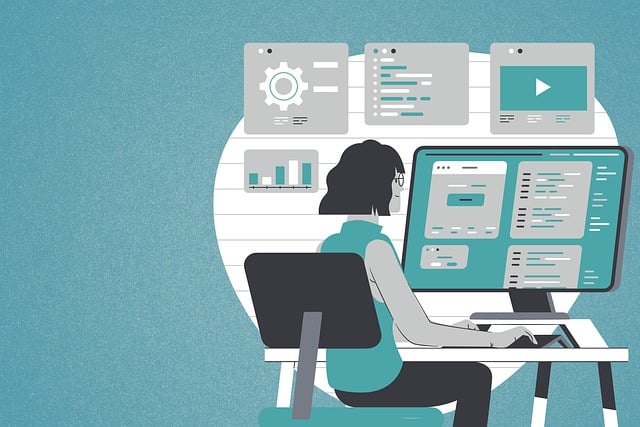In B2B marketing, understanding target audience demographics, pain points, and purchasing behaviors is crucial for creating successful webinars and virtual events that drive lead nurturing. By personalizing content, leveraging interactive elements, and using strategic paid ads (such as SEM and social media advertising), marketers can enhance engagement, build trust, and convert leads into loyal customers. Effective planning, execution, and post-event communication, along with data-driven optimization, ensure webinars achieve B2B marketing goals by refining lead quality and increasing conversion rates.
In today’s digital landscape, educational webinars and virtual events are powerful tools for B2B marketers to nurture leads. This comprehensive guide explores how to create compelling content that resonates with your target audience. From understanding audience needs through paid ads for B2B marketing to hosting successful events and measuring performance, each step is crucial in converting leads into loyal customers. Discover best practices and strategies to optimize your webinars and elevate your virtual event experience.
Understanding Your Target Audience for Effective Webinar Content Creation
Understanding your target audience is a cornerstone in creating impactful webinars and virtual events for lead nurturing. To craft engaging content, tailor your approach to the specific needs, challenges, and interests of your ideal customers. Conduct thorough market research to gather insights on their demographics, pain points, and purchasing behaviors. This knowledge will enable you to develop relevant topics, solve their pressing issues, and use language that resonates with them.
In a B2B context, where paid ads are often the primary marketing strategy, webinars offer a unique opportunity for deeper engagement. By targeting specific buyer personas through personalized content, you can move prospects further down the sales funnel. Ensure your webinar topics align with industry trends, emerging technologies, or best practices relevant to their roles, fostering a sense of value and expertise that attracts and retains their attention.
Designing Engaging Webinar Content That Converts Leads
Creating engaging webinar content is an art that can significantly boost your lead conversion rates, especially in B2B marketing where paid ads often drive targeted traffic. The key lies in crafting a narrative that not only informs but also captivates and interacts with your audience. Start by identifying the pain points and interests of your ideal leads; tailor your content to address these issues, offering practical solutions or insights they can’t find elsewhere. This could include case studies demonstrating successful implementations, expert panels discussing industry trends, or interactive sessions where attendees can ask questions and receive personalized advice.
Use visual aids, real-time polls, and breakout rooms to increase audience engagement. These interactive elements not only make your webinars more dynamic but also provide valuable data points to assess lead interest and understanding. By incorporating these interactive components, you create a two-way communication channel, fostering a sense of community and building trust—essential factors in converting leads into loyal customers. Additionally, pre-recorded webinars with live Q&A sessions can cater to various schedules, maximizing your reach and the potential for lead conversion.
Leveraging Paid Ads for B2B Marketing to Attract Attendees
In today’s digital landscape, leveraging paid ads for B2B marketing is a strategic move to attract attendees for educational webinars and virtual events. These targeted advertising campaigns enable businesses to reach their ideal audience by showcasing relevant content and offers. By utilizing search engine marketing (SEM) and social media advertising, B2B companies can effectively drive traffic to their event registrations, increasing lead generation and nurturing opportunities.
When designing paid ads for B2B marketing, it’s crucial to create compelling copy that speaks directly to the pain points and interests of potential attendees. Highlighting the value proposition—such as exclusive insights, industry expert speakers, or interactive workshops—can pique curiosity and motivate professionals to register. Additionally, using retargeting strategies ensures that those who have previously shown interest in similar events are reminded, fostering continued engagement and attendance.
Best Practices for Hosting Successful Virtual Events
Hosting successful virtual events involves careful planning and execution. Firstly, define clear objectives aligned with your B2B marketing goals, whether it’s generating leads or enhancing customer engagement. This will guide your content strategy and help you tailor sessions to attract and retain your target audience. Utilize interactive elements such as live demonstrations, polls, and breakout rooms to foster participation. Ensure smooth technical setup by testing platforms well in advance and having backup plans for any potential glitches.
Promote your events effectively using paid ads tailored for B2B audiences. Leverage social media, email campaigns, and industry-specific forums to reach the right people. Offer valuable content that addresses pain points of your audience, such as webinars featuring industry experts or case studies showcasing successful implementations. Additionally, maintain open lines of communication through post-event follow-ups, providing access to recordings and resources for those unable to attend live.
Measuring and Optimizing Webinar Performance to Nurture Leads
Measuring and optimizing webinar performance is crucial for effective lead nurturing in B2B marketing. After hosting a webinar, track key metrics such as attendance rates, engagement levels (e.g., live questions, polls), and conversion ratios. Analyze these data points to identify what’s working and what needs improvement. For instance, if you notice low engagement, consider refining your content or delivery methods for future webinars.
Additionally, integrate webinar performance into your broader paid ads strategy. Use insights from webinar metrics to optimize ad campaigns by tailoring messages to engaged audiences and testing different calls-to-action. This data-driven approach ensures that your B2B marketing efforts are continually refined, resulting in better lead nurturing and higher conversion rates.
Creating educational webinars and virtual events is a powerful strategy for B2B marketers to engage and nurture leads. By understanding your target audience, designing compelling content, leveraging paid ads for B2B marketing, and implementing best practices for hosting, you can deliver successful virtual experiences that convert leads into loyal customers. Continuously measure and optimize webinar performance to refine your approach and maximize ROI in today’s digital landscape.
